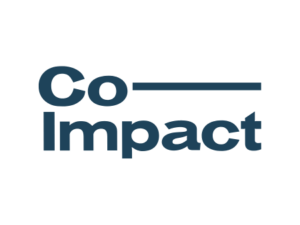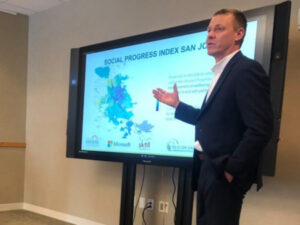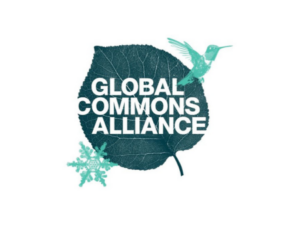Conexsus addresses the gaps that prevent the development of a forest-based economy by building bridges between community-based sustainable agriculture enterprises and diverse sources of support and capital. Working with a host of partners, Conexsus supports local enterprises with forest management and production training, business model and strategy support, access to appropriate financial tools, technical assistance for loan repayment, and improved connections to markets.
Fabiola Zerbini of Conexsus spoke with Ambika Samarthya-Howard on March 17, 2025. Click here to read the full conversation with insights highlighted.
Ambika Samarthya-Howard: Can you introduce yourself and speak about Conexsus’ approach, specifically their market approach?
Fabiola Zerbini:I just started at Conexsus. I am the former forest director for the Brazilian Environmental Ministry, [where I worked] for almost two years. Before that, the World Resources Institute. Before that, I was at the World Economic Forum, always working on land use and climate—connected with conservation, restoration, and sustainable use. [I have a] long history, a long background on that.
At Conexsus, I’m new, but it’s interesting because it will also be an opportunity for me to bring the vision that we are now building in terms of consolidating the assets and the wonderful things that Conexsus has been working on from the beginning to today. And looking at how to model it in a way that we can build another phase, another moment for Conexsus, where scaling, interconnection, and systemic change is more and deeply in the center of our actions and plans.
The main approach of Conexsus is focused on what we call social bioeconomy. I don’t know how familiar you are with this concept. It’s about having life in nature at the center of the economy, but not only having the social portion. Really, using the natural resources, the forest, the natural vegetation, and all the biodiversity, all the issues connected with nature as an asset for a new economic development model where people and nature now are integrated in a current, intelligent, and sustainable way.
By saying that, we have many challenges. This kind of economy, the social bioeconomy, is not the status quo. We do have many actions to be done with the producers—the cooperatives, the associations, the people who are working on the ground and trying to make this forest economy, this social bioeconomy. We need to connect these people with other buyers and with finance and investors.
There are two to three steps that need to be taken as this is very well developed in one or two of these, but we do need to go further into the third one. Working with the cooperative, working with the producer per se, we do have a great methodology about how to teach them to be more professional on business management, on business perspectives.
Ambika Samarthya-Howard: When you say to teach ‘them’, you mean the forest cooperatives?
Fabiola Zerbini: Exactly. I mean the familiar agriculture, but also agro extractivists. It could be IPOCs, so Indigenous people and local community organizations. It could be family agriculture organizations. In Brazil, we have a bigger concept for this. We have an International Private Leased Circuit (IPLC). There’s one interesting thing that connects them, which is the collective territories. We have many legislations in Brazil that allow them the right to have land and collective land, but each of them are in one stage.
There are many differences between them, but we can consider them as a priority group for this social bioeconomy. Indigenous peoples, local communities, which means people who live in the forest, like inside conservation units or inside non-protected areas, or people who work with familiar agriculture. It could be for their own survival, but mostly people who are producing to sell. It could be agroforestry, it could be many different models, but they are the main public of the social bioeconomy.
Ambika Samarthya-Howard: Thank you for explaining that to me. Your main role in terms of that is to make sure that they’re more formalized and that they know how to do the trade?
Fabiola Zerbini: The first step is to really provide technical assistance or even training, but the main point is be with them and try to give them their own capacity to manage their own business. Empowered and emancipated, the sooner the better, because the idea is to really help them to evolve in this sense.
The second piece is you need to connect the cooperatives, the associations, the production groups. You need to activate an ecosystem of business, an ecosystem of governance in the territory where they are. Activating the ecosystem of business means building governance but also building economical interconnections between producers and buyers, producers and agri-industry cooperatives. Verticalized production, producers, and financials.
It’s crucial to really guarantee that this happens. Many things need to be interconnected to really have that producer who knows how to manage their own business and also knows how to connect with others to really go further. The third step is the responsible fair trade or the responsible conception. Really guaranteeing that the selling process or the commercialization will be done following some of the fair trade rules.
Ambika Samarthya-Howard: Yes, that’s much more the supply chain, the supply action chain and value add, right?
Fabiola Zerbini: Yes, the supply chain is part of all of these concepts, but also guarantees that they will have buyers, but not just any buyer, because there are principles that need to be followed. Developing a sustainable social bioeconomy demands a different way to see, like the consumption and the commercialization piece. Having these public procurements, this is one of the main fields that we work to open to these producers, but also fair trade in an international concept helps you build different arrangements with companies to guarantee that the value chain is also not any value chain.I know the value concept first itself, it means better conditions, but fair trade could go further. It could be more.
The fourth piece is financial, which Conexsus has been working a lot experimenting and managing different funds; seed money normally, or microcredit. That together with the technical assistance, the first step, the activation of the ecosystems, building a fair trade and a responsible consumption relationship to all of this and the seed money or the microcredit going together with the rural credit. Money being injected but in a responsible way. This is the pack that Conexsus does and has been experimenting with more than 300 cooperatives and 8 territories in different levels, in different supply chains.
Ambika Samarthya-Howard: Is it possible for you to show me or tell me an example of a place or a group that you did all of this with so I could follow this workflow? If you have a specific example, it’ll help illustrate it.
Fabiola Zerbini: There are some cooperatives on Marajó Island. Marajó is part of Pará here, but it’s on a specific island. Avina also works there. There’s one cooperative there. I had never been there, but since my previous work I had heard about Conexsus—what was and what is the role that Conexsus played with them. This is through the technical assistance and the whole activation of the ecosystem which is also now happening more with the Avina project, but mainly the financial and the technical assistance going together. They got more than R$4 million Reais in rural credit. You can imagine, each contract is around R$4,000.
The R$4 million means that many agriculturists are familiar because they are individuals that together participate in one cooperative, but the rural credit is accessed by each individual, each familiar agriculturist. Each contract was R$4,000 and they got R$4 million. There are more than 100 contracts.
Ambika Samarthya-Howard: Who are the contracts with? They’re with the cooperative and then they’re with a financier?
Fabiola Zerbini: It is a public program that Brazil has had for a long time, a rural credit program, which has a small portion for smallholders. The big rural credit program is around R$400 billion that is being distributed by the government as a credit. It’s reimbursable, but with very special conditions for the smallholders. This is a very important public policy to really inject money and also activate the economy for the smallholders.
I can say this is one of the most beautiful cases of success because you cannot access all this money together, 100 people, without a very important role from technical assistance, but a very customized technical assistance. People there working and talking and planning how to use that, planning how to put this in a collective perspective, not only in an individual one.
I don’t have the numbers here, but we do have some figures about how much revenues increase from this experience. This is not something happening one time. The next steps are better conditions for the products that they are producing. What I can tell you is that it’s one case, an interesting case, where from an individual to collective perspective, they really got some great numbers but also great results using the credit and using the new opportunities that the whole work being done together brought to them.
The activation of the ecosystem is a new project that doesn’t have results yet, but will really work on that, like the Marajó Resiliente, the Project De La Vina. At least the technical system, the finance piece and the responsible consumption or the fair trade piece, the three of them are working well together in this specific case.
Ambika Samarthya-Howard: I wanted to ask you specifically about the fourth piece around microcredit and around financing. Some of this is private-public partnerships. How can private industries be responsible or try to help with sustainability, but at the same time help with livelihoods? Do you work with both private enterprises around that and the government? How you navigate that.
Fabiola Zerbini: First, I think we have a very special situation here in the country, which is around this public policy on rural credit. This is amazing if you compare it with any other country. We’ve been fighting to increase the rural credit portion for smallholders because the other portion goes to the agribusinesses, the medium and bigger producers. What we realize is that it’s not only about how much or the amount, but it’s also about how to really build the conditions in a way that promotes development and doesn’t promote more debt or other bad economic situations for those who do not know how to manage this. We are not alone, but we do have a very unique role in that, but the work that Conexsus does is crucial to really guarantee that the public policy is accomplished with its own purposes. Because today, we do not have more than 50% of this amount being accessed.
The public policy is not working. Considering the condition even of it being reimbursable. And there’s a governmental subsidy. We are talking about, to tell you in dollars, R$70 billion, which means around $15 billion per year. For smallholders, this means a lot.
To make it happen, you need to combine with other funds on the ground. You need to really combine this with technical assistance, with a very individualized following process. We do this through what we call the credit activator. We have this person on the ground. Each territory, each cooperative has a credit activator. They work with the technical assistant on the ground and with the communitarian business, who are normally chosen by the cooperatives and live in the territories.
Just to give you a sense, we have 77 credit activators now working under the Conexsus credit network. They are all around the Amazon and also in the south of Bahia. They follow the cooperative for around 18 months. They receive a small amount of money to guarantee this is their job. What they do is to activate credit. They support people to make financial decisions. Conexsus is accredited by BASA, which is the Amazon bank, and Caixa Econômica Federal, which is one of the national, bigger banks.
Just to tell you that all this work, the credit activators, the technical assistance, and the activation of the ecosystems, all of this needs philanthropic or private money because the rural credit just goes to the producer. These public and private mechanisms are more demanding than ever and we need to really leverage it to put this in a different perspective of scale.
First, we have to really work together with the government—the ones who are formulating the public policy—to acknowledge this is not working. Now you need to combine other support projects together with the rural credit to make it happen in a proper way because the whole mechanism was not developed for the smallholders, was not developed for the public that we know, and this is why. Really work with the government, pushing them to combine other public policies together with the rural credit to guarantee that the R$70 billion or R$15 billion will activate new businesses.
This is one piece. The other is to bring philanthropy and the private sector, the ones who are connected with that kind of product that is being introduced. If it is, I don’t know, cocoa, let’s bring the cocoa and the chocolate industry and philanthropy. Not only the private money but mainly from those who are interested in that supplier, who can also play a double role as the soy traders. Soy traders finance and buy. Why not create this kind of arrangement?
For sure, guaranteeing that the smallholder, the family agriculture, the IPLCs are involved in a way that we respect their own time and the level of maturity that they are, but also create an evolution and a phasing-out perspective to really guarantee that they are empowered as economic actors. Conexsus is the one that works with them to guarantee the relationship with the private money, but also access to the public funds. It is very complex and difficult.
My vision is that a combination of better public policy should guarantee to unlock that amount of public money that is very considerable and can make a big change on the ground. And then, combining that with philanthropic funds and different investment perspectives from the private sector and impact investment family funds.
Ambika Samarthya-Howard: I want to go back a little bit to the local communities and the Indigenous communities that you’re working with. What is the overlap with the smallholder businesses and the cooperatives and the Indigenous communities and local communities?
Fabiola Zerbini: Departing from a land perspective, you have conservation units and you’ll have Indigenous territories and you’ll have settlements. We have four to five different categories of conservation units where people who have been living there since the beginning can live from the resources of the territory. FLONA, which is national forest, or RESEX, which is the extractivist reserves, we do have different categories by the law. Each allows people who live inside to use that forest in different ways. Local communities normally are inside these conservation units. They have been living there for a long time. They can make sustainable forest management. Some places are timbers, some places non-timber only, but normally both. They do have some commitments or obligations in terms to conserve or to restore. These are the local communities.
The Indigenous peoples are a little bit different. They have Indigenous territories and there are different laws that manage those territories. They manage how Indigenous people can use that territory, that land and the resources inside, to really get their own sustainable food, but also to sell. From the legislation that regulates each land use, you start having differences between these groups, IPOCs. Normally, they had a lot in common because they are the guardians, the places where they normally are the most conserved in the country. They do have a lot of problems to really access the best instruments or the ways to use the land, not only having the right to use the land, but they do need technical assistance, they do need seeds, they do need support to work.
We also have different languages and different perspectives in terms of how to deal with land that requires different processes. The family agriculture is a little bit more, because they are all around the country. They are very different from the South to the North. We are the biggest family agriculture rice producer in Latin America. I can imagine that the rice in Latin America comes mainly from family agriculture. 30% of the food that is distributed in the country comes from family agriculture.
Settlements is the third category. It’s family agriculture, but more than this. They do not have land. It’s public-to-private land. This is the most crazy model that we have, the settlements. The public departments that care for the settlements, they are one of the least structured in the country, unfortunately, which is INCRA and the Land Tenure. It’s not easy for them, but they are a different category. Again, they are collective territories. These are normally people who do not have land to produce and people who are under poverty levels, people who really need to be included in some social program so that they can use the land to survive, to plant for their own selves, to eat, for food security, and also to create some economic connectivity.
Ambika Samarthya-Howard: It must be true for all the groups that they need the land to survive, that they need food assistance and all of that stuff, right?
Fabiola Zerbini: Yes. The main point is that all of them need to be prioritized, and all of them have a great potential to bring this sustainable forest economy in a scale perspective because they are many groups. Each needs and demands different instruments to arrive at the same place.
Ambika Samarthya-Howard: What do each of these communities need in order to get to where they need to get to?
Fabiola Zerbini: I think first they need this support from the ground. Again, there are different levels of maturity, and if you have a system that really helps them to see where they are on that development cycle and work to guarantee that depending on the stage that they are at, they will receive what they need. Conexsus has four-stages of maturity categories. Each category has a specific demand. You need more technical assistance. You are ready for an investor. Or you need philanthropy.
All of them need support to develop the business and the production capacity as much as we could work from a landscape perspective. Really putting a huge effort into developing this ecosystem of businesses and at the same time, building local governance because they need to be engaged. Making the bridge between the financiers, the investors, and the public money as well, the rural credits and really bringing that money, but in a way that makes sense and is responsible for the stage that they are at.
This is the same for each local community, indigenous people, and settlement. All of them need the same, but the instruments, the language, the rhythm, the expectations, the development cycle are different because each has a unique situation. The way that they arrive to the land, how much ownership they do have with the land, and what are the rules that they follow? The Indigenous follow their own cosmogony.
Ambika Samarthya-Howard: In terms of your impact or in terms of how you’re measuring success, how do you know what you’re doing is working?
Fabiola Zerbini: I’m still learning as well how Conexsus monitors, evaluates and learns from their own work. What we do have is the figures about how much money was unlocked and how many families are engaged. More than the number of families, for instance, 98% of the families that access the rural credit through our processes are engaging for the first time. And half are women. We also try to bring the gender aspects.
Ambika Samarthya-Howard: 98% of the people that Conexsus engage with, it was their first time engaging with that public credit? Why hadn’t they engaged before?
Fabiola Zerbini: The demand is huge, that’s why we need this kind of job being done on the ground. What we need is to reinforce, to strengthen this kind of thing. We are now working to organize our call for action to revise this public policy. Systematizing the difficulties and what needs to be done and the reality from the ground to inform the public policy maker about how things are and how to change this.
You will never get the scalability that you need by just adding more cooperatives. You need to change the rules. It needs to go together. We can increase our job and do it 100 times bigger, but it still does not work because we need to change the public policy. We need to give the private sector a different responsibility in a different piece of this equation.
We have developed an environmental monitoring system. What I know is that this is something that we are testing with some of the cooperatives that we are more connected to, to also allow them to evaluate themselves from an environmental perspective. It’s not a certification, but it will help us give some environmental impact to those investors who are interested in that, but allow the producers, and the cooperatives to negotiate or to talk with other buyers.
Ambika Samarthya-Howard: I’m curious from your side, having worked in governments and now having worked on the other side, what do you feel are the most surprising things about the work that you’re doing or about climate action in general?
Fabiola Zerbini: Conexsus is really walking the talk now in terms of social environmental action. The social bioeconomy. The social piece is as important as the environmental one. This is why I look to Conexsus as having potential. There’s no way to really change the environmental problem without including social inequality in the equation.
To build a different way, to make a new economic development model, means that you need to bring people and the social economy together with the biophysical to make decisions [for sustainability]. It is one piece. The other is the potential of bringing different players to the table to address old problems. New people or new solutions to old problems. The rural credit is another problem. It’s a very old problem. We know that people do not access it. We know that there’s so many gaps. We know that.
I can see how respected Conexsus is in the work that they are doing, and the amazing opportunities that Conexsus has ahead if we work well. We do have some gaps, internal ones, and contextual ones. It’s amazing how rich the results are so far, and the potential that we have. The time is now to make it better. We are in a geopolitical context that is very complex. Part of the money that we have for this year was cut by USAID. There’s a lot of others who are dependent on philanthropy. It’s crazy and really big, not only for us but for all.
Ambika Samarthya-Howard: What do you think are some of the biggest mistakes Conexsus has made, or what are some of the things that you guys have learned if people wanted to replicate what you’re doing in terms of using public-private funds?
Fabiola Zerbini: The philanthropic dependency. We really need to find other ways to generate income. Incomes not profits. Revenue. We need to also find ways to move, to push the economy, [to push] ourselves. When we are working with these agendas, keeping the essence, keeping the main mission to really work on social development and environmental social development, but putting ourselves as part of the equation and really guaranteeing that we will not need to follow projects or funders again and again. We will have some self-sustainable way to keep working and to also give some safety to those who are on the ground because we will be there.
We will not depend on a project. We do have a vision and we have a strategic plan to arrive at that vision. We need to think outside of the box to really guarantee that we will not repeat the mistake of being very philanthropic dependent or project dependent oriented. We need to be more strategic-oriented. Also in a way that we are self-sustainable. We need to talk more about risk management, because the private sector and the finance sector do not want to change anything in terms of how they deal with risk.
The cooperatives, the associations, the IPLCs, all of us as citizens and Conexsus are normally taking a lot of risk. The private or finance sector should assume more risk than them. I think this is also another mistake that we should never repeat again.
Ambika Samarthya-Howard: Thank you for your time and insights!
Fabiola Zerbini: Thank you so much, Ambika.
Click here to read the full conversation with insights highlighted.
Ambika Samarthya-Howard Samarthya-Howard (she/her) is the Solution Journalism Network’s Chief Innovation Officer: She leads on innovation and technology, leverages communication platforms for the network strategy and creates cool content. She has an MFA from Columbia’s Film School and has been creating, teaching and writing at the intersection of storytelling and social good for two decades. She has produced content for Current TV, UNICEF, Havas, Praekelt.org, UNICEF, UNFPA, Save the Children, FCDO, Global Integrity and Prism.
* This interview has been edited and condensed.
Read about other social innovators bringing together varied experts.







